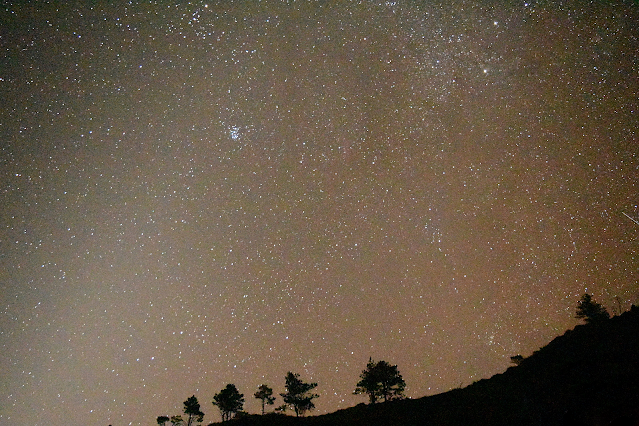“I can’t do this anymore,” the voice ran in my head tens,
maybe hundreds of times. The dawn was cold and harsh, and the pain on my hip and spine from carrying a 16-kilogram child was close to where I’ve been during the
final minutes of rearing her into the world.
Rey, were gone. We had been slowing them down, so we asked them to go ahead so they can catch Mt.
Pulag’s famous sunrise.
our lifeline, the mess that we are, fixing our oversized bag and faulty toddler
carrier that drooped endlessly. Just us, we had fears: fears of falling into a
ravine that we cannot see, fears of not making it to the top after traveling
nine dizzying hours across the Cordillera mountains.
We left our homestay 10 minutes north of the Ranger Station at 2:20 am. The first hour saw us brisk and brimming with hope as we walked on a straight and gentle path that, we imagined, may be boring in daylight.
Jigs carried Lia on his back for nearly an hour until she suddenly woke up crying in a borrowed Tula. For 15 minutes, she walked silently, her winter boots burrowing and slipping in mud. Amused trekkers fleeted in throngs, cheering Lia and telling her she’s lucky to be in Pulag at three years old.
So, I carried her. I carried her till we reached Camp 1, where we huddled with other hikers in a small shed, under the moon and the stars. I carried her through throngs of people squeezing themselves in a narrow, mushy, and endless abyss called mossy forest. I carried her until the throngs we left in Camp 1 overtook us and we were the only ones left in the dark, bearing the sound of our breaths amid the strange noises of insects and wind
Every two minutes, I slumped on tree barks and moss-covered stones – beanie soaked in sweat, watching white mist escape from my mouth into thin air. The cold seeped through the layers of polyester, wool, and fleece. Even in the comforts of our tightly shut, fanless homestay room, balmy air swathed every nerve and bone.
It was already 4:30 am and our guide, Ate Eva, said we’re not even halfway through. The pain on my hip, once manageable, turned monstrous and searing. It teared every filament of will.
even birthed my daughter into the world. I wanted it after. I wanted to bring her here.
I have wanted.
take you and how far. There, in Mt. Pulag’s wet, endless, and dark deciduous
forest, the line where want and do not want blurred. It kept blurring with pain
and my want to not experience pain anymore. I wished Lia said yes when we asked
her if she wanted to go back.
every week for a month in preparation for Mt. Pulag. I went on monthly climbs with Lia. The Ambangeg Trail is easy. But nothing prepared me enough for the brunt of climbing a high-altitude, low-oxygen mountain against five hours of wintry air and the
infinite pain of carrying a heavy toddler in pitch-black darkness.
coat for half an hour. Follow where the light leads, it said. So I did, even if
getting there was unbearable.
Because I wanted this. For myself. For my daughter.
Step, step, step, sit. Step, step, step, sit.
started to creep in, and the night gave way.
Camp 2, which was around 30 minutes away
from our final destination at Peak 5. We weren’t going to the summit itself; we couldn’t make it in time anyway. The
blanket of trees receded until there was none but fringes. From a distance, a green
sign read: Camp 2 Grassland Summit.
At the grassland were endless clutches of
mountains lined with dwarf bamboos and eerie trees, all bathing in the golden
rays of the sun. I sat on a naked patch of earth and placed
Lia, still asleep, on my lap. “We are in Mt. Pulag, Lia. Nandito na tayo, anak.” I whispered.
We are here and we are sharing a dream. The tears, like the happiness of that dream coming to life, were uncontrollable.
6:40 am, my watch reads. We were 20 minutes
late for Pulag’s larger-than-life sunrise and we were the last of
approximately 500 people that day to make it to Mt. Pulag’s peak. Yet none of it mattered. The sobering
reality was, however the sun turned, we were, both spirit and body, in Mt. Pulag. Our
feet, our souls, within arm’s reach of the heavens.
Lia mused blithely at trees and people – who beamed with pride and happiness for her and Skye, that day’s youngest trekkers – as she trod all eight kilometers back.
explained in words. It is magical to say the least – the scent of trees, the
clouds rising above peaks, the violet and blood red flowers, the strings of
moss hanging from century-old barks, the soaring pines fringing on ravines. For some, that magic stems from the high of numbers, of reaching Luzon’s loftiest peak.
This peak is prominent for its antenna tower.























